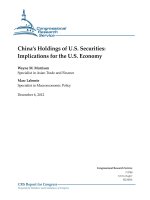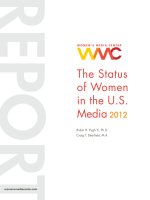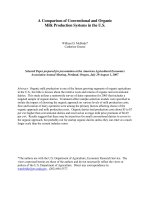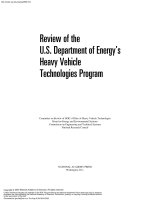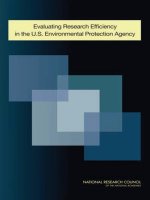Evaluating Progress of the U.S. Climate Change Science Program: Methods and Preliminary Results pdf
Bạn đang xem bản rút gọn của tài liệu. Xem và tải ngay bản đầy đủ của tài liệu tại đây (1.8 MB, 267 trang )
Committee on Strategic Advice on the
U.S. Climate Change Science Program
Division on Earth and Life Studies
Division of Behavioral and Social Sciences and Education
THE NATIONAL ACADEMIES PRESS • 500 Fifth Street, N.W. • Washington, DC 20001
NOTICE: The project that is the subject of this report was approved by
the Governing Board of the National Research Council, whose members
are drawn from the councils of the National Academy of Sciences, the
National Academy of Engineering, and the Institute of Medicine. The
members of the committee responsible for the report were chosen for
their special competences and with regard for appropriate balance.
This study was supported by the National Aeronautics and Space Ad-
ministration under Award No. NNH07CC79B. Any opinions, findings,
conclusions, or recommendations expressed in this publication are those
of the author(s) and do not necessarily reflect the view of the organiza-
tions or agencies that provided support for this project.
International Standard Book Number-13: 978-0-309-13173-5
International Standard Book Number-10: 0-309-13173-1
Library of Congress Control Number: 2009923757
Additional copies of this report are available from the National Acad-
emies Press, 500 Fifth Street, N.W., Lockbox 285, Washington, DC
20055; (800) 624-6242 or (202) 334-3313 (in the Washington metropoli-
tan area); Internet .
Cover: Designed by Van Nguyen.
Copyright 2009 by the National Academy of Sciences. All rights reserved.
Printed in the United States of America.
The National Academy of Sciences is a private, nonprofit, self-perpetuating
society of distinguished scholars engaged in scientific and engineering research,
dedicated to the furtherance of science and technology and to their use for the
general welfare. Upon the authority of the charter granted to it by the Congress
in 1863, the Academy has a mandate that requires it to advise the federal gov-
ernment on scientific and technical matters. Dr. Ralph J. Cicerone is president
of the National Academy of Sciences.
The National Academy of Engineering was established in 1964, under the
charter of the National Academy of Sciences, as a parallel organization of out-
standing engineers. It is autonomous in its administration and in the selection of
its members, sharing with the National Academy of Sciences the responsibility
for advising the federal government. The National Academy of Engineering
also sponsors engineering programs aimed at meeting national needs, encour-
ages education and research, and recognizes the superior achievements of
engineers. Dr. Charles M. Vest is president of the National Academy of Engi-
neering.
The Institute of Medicine was established in 1970 by the National Academy
of Sciences to secure the services of eminent members of appropriate profes-
sions in the examination of policy matters pertaining to the health of the public.
The Institute acts under the responsibility given to the National Academy of
Sciences by its congressional charter to be an adviser to the federal government
and, upon its own initiative, to identify issues of medical care, research, and
education. Dr. Harvey V. Fineberg is president of the Institute of Medicine.
The National Research Council was organized by the National Academy of
Sciences in 1916 to associate the broad community of science and technology
with the Academy’s purposes of furthering knowledge and advising the federal
government. Functioning in accordance with general policies determined by the
Academy, the Council has become the principal operating agency of both the
National Academy of Sciences and the National Academy of Engineering in
providing services to the government, the public, and the scientific and engi-
neering communities. The Council is administered jointly by both Academies
and the Institute of Medicine. Dr. Ralph J. Cicerone and Dr. Charles M. Vest
are chair and vice chair, respectively, of the National Research Council.
www.national-academies.org
iv
COMMITTEE ON STRATEGIC ADVICE ON THE
U.S. CLIMATE CHANGE SCIENCE PROGRAM
VEERABHADRAN RAMANATHAN, Chair, University of
California, San Diego
CHRISTOPHER O. JUSTICE, Vice Chair, University of Maryland
JOHN B. CARBERRY, Carberry EnviroTech, Vero Beach,
Florida
ROBERT E. DICKINSON, University of Texas, Austin
EILEEN E. HOFMANN, Old Dominion University, Norfolk,
Virginia
JAMES W. HURRELL, National Center for Atmospheric
Research, Boulder, Colorado
JEANINE A. JONES, California Department of Water Resources,
Sacramento
ROGER E. KASPERSON, Clark University, Worcester,
Massachusetts
CHARLES D. KOLSTAD, University of California, Santa Barbara
MARIA CARMEN LEMOS, University of Michigan, Ann Arbor
PAOLA MALANOTTE-RIZZOLI, Massachusetts Institute of
Technology, Cambridge
ELLEN S. MOSLEY-THOMPSON, Ohio State University,
Columbus
ARISTIDES A.N. PATRINOS, Synthetic Genomics, Inc., La Jolla,
California
GUIDO D. SALVUCCI, Boston University, Massachusetts
SUSAN E. TRUMBORE, University of California, Irvine
T. STEPHEN WITTRIG (through November 2008), BP,
Naperville, Illinois
National Academies Staff
ANNE M. LINN, Study Director
GREGORY H. SYMMES, Deputy Executive Director
JARED P. ENO, Research Associate (from November 2007)
JODI BOSTROM, Research Associate (until November 2007)
v
Preface
The U.S. Climate Change Science Program (CCSP) is devel-
oping a new strategic plan to replace the one that has guided
federal research since 2003. The new strategic plan is expected to
be released early in the next administration. There is thus an oppor-
tunity to step back, examine what has been learned, and chart a
new course for the future. The National Research Council’s Com-
mittee on Strategic Advice on the U.S. Climate Change Science
Program was established to evaluate progress of the CCSP and to
identify future priorities. Its first report, Evaluating Progress of the
U.S. Climate Change Science Program: Methods and Preliminary
Results (NRC, 2007c), drew the following conclusions about the
progress of the CCSP:
• Discovery science and understanding of the climate system
are proceeding well, but use of that knowledge to support decision
making and to manage risks and opportunities of climate change is
proceeding slowly
• Progress in understanding and predicting climate change
has improved more at global, continental, and ocean basin scales
than at regional and local scales
vi PREFACE
• Our understanding of the impact of climate changes on
human well-being and vulnerabilities is much less developed than
our understanding of the natural climate system
• Science quality observation systems have fueled advances
in climate change science and applications, but many existing and
planned observing systems have been cancelled, delayed, or de-
graded, which threatens future progress
• Progress in communicating CCSP results and engaging
stakeholders is inadequate
• The separation of leadership and budget authority presents
a serious obstacle to progress in the CCSP
This is the second report and it identifies priorities for address-
ing these issues and for meeting new scientific and societal needs.
To gather input and discuss the issues, the committee held five meet-
ings and two major workshops. Most of the meetings were focused
on particular issues, including priorities for CCSP components and
for the program as a whole, and communicating scientific under-
standing for management and policy making. The first workshop
focused on stakeholders and applied research, regional modeling,
and data needed to support adaptation and mitigation in various sec-
tors, climate policy, and national assessments (see Appendix F for
the agenda and list of participants). The second workshop focused
on basic natural and social science research, ways to balance com-
peting priorities, and ways to make an interagency coordinated
program work (Appendix F).
The committee also solicited essays from colleagues. Of par-
ticular note are the comprehensive summaries of research priorities
in the natural sciences and the human dimensions prepared by the
chair and staff of the Committee on the Human Dimensions of
Global Change and the Climate Research Committee (Appendixes
D and E). The committee extends its thanks to those committees
and especially to the chairs (Thomas Wilbanks and Antonio Busa-
lacchi) and staff (Ian Kraucunas and Paul Stern). Other colleagues
who contributed substantial material or helped the committee sort
through ideas include Dan Brown, Michael Hanemann, David
Skole, and Kirk Smith. The committee greatly appreciates their
contributions.
PREFACE vii
The committee also thanks the many other individuals who
gave presentations, led working group discussions, or provided
other input to the committee: Rick Anthes, Peter Backlund,
Roberta Balstad, Bruce Barkstrom, Jonathan Black, William Bren-
nan, Dixon Butler, L. Greg Carbone, DeWayne Cecil, Javade
Chaudhri, Eileen Claussen, Andrew Comrie, Kevin Cook, Lisa
Dilling, George Eads, William Easterling, Jae Edmonds, Jack Fel-
lows, Guido Franco, Sharon Hays, Issac Held, Anthony Janetos,
Timothy Killeen, Chet Koblinsky, Martha Krebs, Kent Laborde,
Dennis Lettenmaier, Ruby Leung, Roger Lukas, Alexander Mac-
Donald, Linda Mearns, Susanne Moser, Jon Padgham, Adam
Phillips, Roger Pielke Jr., Andrew Revkin, Sherwood Rowland,
Jason Samenow, David Schimel, Stephen Schneider, Peter Schultz,
Susan Solomon, Michael Stephens, Susan Tierney, Kevin Tren-
berth, Compton Tucker, Robert Waterman, Anne Watkins, and
Julie Winkler. Finally, the committee chair, vice chair, and the en-
tire committee express their deep gratitude to Anne Linn, the study
director, and the other NRC staff for their outstanding work in or-
ganizing the workshops and preparing the report and guiding it
through the review and publication process.
V. Ramanathan, Chair
C. Justice, Vice Chair
ix
Acknowledgments
This report has been reviewed in draft form by individuals cho-
sen for their diverse perspectives and technical expertise, in
accordance with procedures approved by the NRC’s Report Review
Committee. The purpose of this independent review is to provide
candid and critical comments that will assist the institution in mak-
ing its published report as sound as possible and to ensure that the
report meets institutional standards for objectivity, evidence, and
responsiveness to the study charge. The review comments and draft
manuscript remain confidential to protect the integrity of the delib-
erative process. We wish to thank the following individuals for their
participation in the review of this report:
Richard A. Anthes, University Corporation for Atmospheric
Research, Boulder, Colorado
Robert H. Austin, Princeton University, New Jersey
Edward A. Boyle, Massachusetts Institute of Technology,
Cambridge
F. Stuart Chapin, University of Alaska, Fairbanks
Grant Davis, Sonoma County Water Agency, Santa Rosa,
California
Mark Fahnestock, University of New Hampshire, Durham
Margaret S. Leinen, Climos, Inc., Alexandria, Virginia
x ACKNOWLEDGMENTS
Linda O. Mearns, National Center for Atmospheric Research,
Boulder, Colorado
M. Granger Morgan, Carnegie Mellon University, Pittsburgh,
Pennsylvania
Susanne C. Moser, Susanne Moser Research & Consulting, Santa
Cruz, California
William D. Nordhaus, Yale University, New Haven, Connecticut
Jonathan A. Patz, University of Wisconsin, Madison
Although the reviewers listed above have provided many con-
structive comments and suggestions, they were not asked to
endorse the conclusions or recommendations nor did they see the
final draft of the report before its release. The review of this report
was overseen by Kenneth H. Brink, Woods Hole Oceanographic
Institution, and Marcia K. McNutt, Monterey Bay Aquarium Re-
search Institute. Appointed by the National Research Council, they
were responsible for making certain that an independent examina-
tion of this report was carried out in accordance with institutional
procedures and that all review comments were carefully consid-
ered. Responsibility for the final content of this report rests entirely
with the authoring committee and the institution.
xi
Contents
SUMMARY 1
1 INTRODUCTION 11
A Changing Context for Climate Research, 11
Committee Charge and Approach, 16
Organization of the Report, 19
2 RESTRUCTURING THE CLIMATE CHANGE
SCIENCE PROGRAM 21
Extreme Weather and Climate Events and Disasters, 24
Sea Level Rise and Melting Ice, 34
Freshwater Availability, 39
Agriculture and Food Security, 50
Managing Ecosystems, 56
Human Health, 66
Impacts on the Economy of the United States, 74
Where Do We Go From Here? 82
3 FUTURE PRIORITIES 85
Climate Observations and Data, 87
Analysis of Earth System Data, 92
Earth System Modeling, 95
xii CONTENTS
Human Dimensions of Climate and Global Change
Research, 98
Decision Support, 102
National Assessment of Climate Impacts and Adaptation
Options, 109
International Partnerships, 112
Top Priorities and Budget Implications, 115
REFERENCES 123
APPENDIXES
A Examples of Bills with a Significant Climate Change
Component Considered in the 110th Congress 149
B U.S. Climate Change Science Program 153
C Process for Identifying Priority Areas 159
D Fundamental Research Priorities to Improve the
Understanding of Human Dimensions of Climate
Change 167
E Research Priorities for Improving Our Understanding
of the Natural Climate System and Climate Change 203
F Workshop Agendas and Participants 227
G Biographical Sketches of Committee Members 243
H Acronyms and Abbreviations 253
1
Summary
limate change is one of the most important global environ-
mental problems facing the world today. Evidence of a
changing climate is all around us, from rising sea level to
retreating mountain glaciers, melting Arctic sea ice, lengthening
growing seasons, shifting animal migration patterns, and other
changes. Such changes are already having adverse impacts on peo-
ple’s well-being, as climate change amplifies the effects of other
environmental and socioeconomic changes and problems and pro-
duces new effects of its own. The long-lived greenhouse gases
already in the atmosphere guarantee that warming will continue,
even if emissions are drastically cut today. But emissions continue
to grow as population and consumption increases. The rising de-
mand for energy, transportation, and food are projected to further
raise emissions of greenhouse gases.
Based on these trends, the Intergovernmental Panel on Climate
Change has predicted that the warming during this century will be
in the range of 1.5°C to 4.5°C, and likely at or close to the upper
level if aggressive actions are not taken to mitigate CO
2
emissions.
At a minimum, the coming decades will continue warming beyond
what societies have experienced in the past, likely causing disrup-
tive shifts in supplies of freshwater and food, increased degradation
of land and ocean ecosystems, and new threats to public health, the
economy, and national security. If the projected warming is abrupt,
C
2 RESTRUCTURING FEDERAL CLIMATE RESEARCH
as has happened at times earlier in the planet’s history, it could
pose formidable challenges for adaptation measures. In the worst
case, warming may trigger tipping points—thresholds for irre-
versible changes in the way Earth’s climate operates and how
human and ecological systems respond.
Given this scenario, it is likely going to be a Herculean task to
limit climate change to 2°C of warming from preindustrial levels
as desired by many governments. The 1997 Kyoto Protocol was an
important initial step toward attempting to manage greenhouse gas
emissions at the international level. At the national level, nearly 80
percent of U.S. states have adopted or are preparing climate action
plans, some of which include mitigation measures such as cap and
trade programs. However, many policy decisions on mitigation
and adaptation are being made without the scientific support that
could help shape better outcomes. Robust and effective responses
to climate change demand a vastly improved body of scientific
knowledge, including observations and better understanding and
predictions of the changing climate system, the human drivers of
climate change, the response of the climate system to these drivers,
and the response of society to climate changes.
The research, observations, and modeling needed to develop
the knowledge foundation for understanding and responding to
climate change at the federal level is the responsibility of the U.S.
Climate Change Science Program (CCSP). At the request of Dr.
James Mahoney, then director of the CCSP, the National Research
Council established a committee to carry out two tasks over a 3-
year period. The report on the committee’s first task, Evaluating
Progress of the U.S. Climate Change Science Program: Methods
and Preliminary Results, was published in 2007 (NRC, 2007c).
The second task—future priorities for the program—is the subject
of this report:
Task 2. The committee will examine the program elements
described in the Climate Change Science Program strategic
plan and identify priorities to guide the future evolution of the
program in the context of established scientific and societal
objectives. These priorities may include adjustments to the
balance of science and applications, shifts in emphasis given
to the various scientific themes, and identification of program
SUMMARY 3
elements not supported in the past. A report identifying these
future priorities will be prepared. The recommendations will
specify which priorities could likely be addressed through an
evolution of existing activities or reprogramming, and which
would likely require new resources or partnerships.
This report lays out a framework for generating the knowledge
to understand and respond to climate change, and identifies priori-
ties for a restructured climate change research program.
A NEW FRAMEWORK TO MEET THE CHALLENGES OF
CLIMATE CHANGE
Dealing with climate change will be one of the biggest chal-
lenges of the next century. The future (post-CCSP) climate change
research program will play a key role by building knowledge,
through sound science and incontrovertible observations, that in-
forms decision making. However, meeting the needs of decision
makers requires a transformational change in how climate change
research is organized and incorporated into public policy in the
United States.
The traditional approach of organizing climate change research
by scientific disciplines (e.g., atmospheric chemistry) or biophysi-
cal processes (e.g., carbon cycle) has led to significant advances
in our understanding of the climate system and the creation of a
robust observations and modeling infrastructure. However, the
paucity of social science research and the separation of natural
and social science research within the CCSP, as well as the insuffi-
cient engagement of policy makers, resource managers, and other
stakeholders in the program are hindering our ability to address
the problems that face society. Solving these problems requires
research on the end-to-end climate change problem, from under-
standing causes and processes to supporting actions needed to cope
with the impending societal problems of climate change. Examples
of societally-important issues where an end-to-end approach is
needed include (1) extreme weather and climate events and disas-
ters, (2) sea level rise and melting ice, (3) freshwater availability,
(4) agriculture and food security, (5) managing ecosystems, (6)
4 RESTRUCTURING FEDERAL CLIMATE RESEARCH
human health, and (7) impacts on the economy of the United States.
Addressing these issues requires the integration of disciplinary and
multidisciplinary research, natural and social science, and basic
research and practical applications.
The committee recommends that the program be restructured
so that the existing CCSP research elements (e.g., atmospheric
composition) and crosscutting themes (e.g., modeling, observa-
tions) contribute directly, although not exclusively, to critical
scientific-societal issues such as freshwater availability, extreme
weather, and sea level rise. The goal should be to evolve the pro-
gram in a way that maintains the current strengths of understanding
and predicting climate change, while building the capability to
achieve the CCSP’s vision of “a nation and the global community
empowered with the science-based knowledge to manage the risks
and opportunities of change in the climate and related environ-
mental systems.” Such a restructuring around scientific-societal
issues is required to help the program become more cross discipli-
nary, more fully embrace the human dimensions component, and
encourage an end-to-end approach (from basic science to decision
support). It should also help the participating agencies better inte-
grate their programs.
TOP PRIORITIES
The committee’s top six priorities, cast as actions for the re-
structured climate change research program, are listed below. They
are presented as a logical flow of actions, although work can begin
on all of them simultaneously. All are necessary to establish a co-
herent program that provides the scientific basis for understanding
climate change and developing informed responses.
Reorganize the program around integrated scientific-societal
issues to facilitate crosscutting research focused on under-
standing the interactions among the climate, human, and
environmental systems and on supporting societal responses to
climate change.
SUMMARY 5
Societal concerns about climate focus on changes that are visi-
ble now (e.g., melting ice) and the impacts of these changes (e.g.,
cost of long-term drought on agricultural production or the avail-
ability of freshwater). Addressing such societal concerns requires a
strong underpinning of observations and models, strengthened re-
search across the board—particularly in the human dimensions of
global change and in user-driven (applied) research that supports
decision making—and increased involvement of stakeholders (e.g.,
federal, state, and local government agencies; the private sector;
environmental organizations).
Establish a U.S. climate observing system, defined as including
physical, biological, and social observations, to ensure that data
needed to address climate change are collected or continued.
The satellite and ground observing systems that fueled our cur-
rent understanding of the climate system are in decline, even as
demand for data capable of detecting climate variability and
change is growing. Sustained, multidecadal observations of physi-
cal, biological, and social processes are required to document,
understand, and predict climate change at the temporal and spatial
scales relevant to federal, state, and local-level stakeholders and
partner international programs. Consequently, the current satellite,
land, ocean, and atmosphere observations of the climate system
need to be continued and augmented. New observations are also
needed—including those to support human dimensions research
for developing and assessing mitigation and adaptation strate-
gies—and existing human-social data need to be better organized
and coordinated with physical climate observations to enable inte-
grated social-natural systems research.
Climate-related observations are made by different federal and
state government agencies, often to meet their own monitoring re-
quirements. Although an interagency working group is developing
a list of high-priority observations, the CCSP has not yet adopted
one. But even with a list of observation priorities, the CCSP lacks
the authority to direct individual agencies to collect, modify, or
maintain them. Rather than relying on the voluntary contributions
of participating agencies, a more strategic approach to data collec-
tion, distribution, and maintenance is needed—one that requires
6 RESTRUCTURING FEDERAL CLIMATE RESEARCH
agencies to work together to design and implement a climate ob-
serving system.
Develop the science base and infrastructure to support a new
generation of coupled Earth system models to improve attribu-
tion and prediction of high-impact regional weather and climate,
to initialize seasonal-to-decadal climate forecasting, and to pro-
vide predictions of impacts affecting adaptive capacities and
vulnerabilities of environmental and human systems.
Further climate change is inevitable, even if humans signifi-
cantly reduce greenhouse gas emissions. It is therefore essential
not only to have the capacity to explain what is happening to cli-
mate and why (attribution), but also to improve predictions of
weather and climate variability at the spatial and temporal scales
appropriate to assess the impacts of climate change. Both will re-
quire improved infrastructure and techniques in modeling the
coupled human–land–ocean–atmosphere system, supported by sus-
tained climate observations. The latter are necessary to further
develop and constrain the models and to start model predictions
from the most accurate observed state possible (initialization).
Tools are also needed to translate the data and model output into
information more usable by stakeholders. Improved predictions of
regional climate will also require more unified modeling frame-
works that provide for the hierarchical treatment of climate and
forecast phenomena across a wide range of space and time scales,
and for the routine production of decadal regional climate pre-
dictions at scales down to a few kilometers. New computing
configurations will be needed to deal with the computational and
data storage demands arising from decadal simulations at high
resolution with high output frequency.
Strengthen research on adaptation, mitigation, and vulnerability.
Adaptation and mitigation strategies depend on an understand-
ing of climate trends (including improved predictions of future
climate change and extreme events), of differential vulnerabilities
and adaptive capacities to climate impacts (including sensitivities
and thresholds and barriers to adaptation), of economic costs and
SUMMARY 7
dynamics, and of human behaviors, policy preferences, and choices;
and on assumptions about the future availability of technologies for
reducing emissions (including cobenefits and unintended conse-
quences of mitigation). Yet the underlying human dimensions
research needed to understand and develop sound adaptation
strategies is a major gap in the CCSP. Although adaptation, mitiga-
tion, and vulnerability research would be needed for all the societal
issues in the proposed new research framework, an additional fo-
cused research effort would help speed results. A critical step in the
process is for agencies with appropriate expertise to increase fund-
ing and take a leadership role in supporting, managing, and directing
this research.
Initiate a national assessment process with broad stakeholder par-
ticipation to determine the risks and costs of climate change impacts
on the United States and to evaluate options for responding.
A comprehensive national assessment with periodic reporting
provides a mechanism to build communication with stakeholder
groups and to identify evolving science and societal needs and pri-
orities. A useful assessment does not merely summarize published
studies, but has the ability to undertake targeted research to pro-
duce new insights, observations, models, and decision support
services. Results of the assessment could be used to help determine
priorities for federal research on impacts, mitigation, and adapta-
tion; provide a focus for integrated science-policy assessments and
enhanced regional modeling and predictions; and build human and
institutional capacity to support decision making. Although the
CCSP is mandated to carry out a national assessment every 4
years, the last one to involve a broad range of stakeholders was
conducted a decade ago. From 2006 to 2008, the CCSP published
21 synthesis and assessment reports on a range of topics and an
overarching synthesis. Although useful, the collection does not add
up to a comprehensive national assessment. A new assessment will
require strong political and scientific leadership, adequate resources,
a careful planning process, and engagement of stakeholders at all
stages of the process.
8 RESTRUCTURING FEDERAL CLIMATE RESEARCH
Coordinate federal efforts to provide climate services (scientific
information, tools, and forecasts) routinely to decision makers.
Demand is growing for credible, understandable, and useful
information for responding to climate change. A comprehensive
approach to supporting decisions on climate change includes two-
way communication with users to determine their information
needs, provision of climate services, and research to support the
services. Although a few pilot efforts are providing selected cli-
mate services, a national program to monitor climate trends and
issue predictions to support decision makers at multiple levels and
in the various sectors has yet to be established. A national climate
service should probably reside outside of the future climate change
research program for a variety of reasons, including the potential to
overwhelm the research program with myriad demands for special-
ized services. Regardless of where the service is established, the
restructured climate change research program would have to be
involved in the research and development of experimental products
(e.g., regional predictions), tools (e.g., models), and outreach ser-
vices needed to support stakeholders. The climate service could
then use the tools to create products operationally. Maintaining
strong links to the research program would also help the climate
service take advantage of new capabilities.
PROGRAMMATIC AND BUDGET IMPLICATIONS
Implementing the above priorities will require good leaders at all
levels with the authority to direct budgets and/or research efforts. Of
particular importance are strong, charismatic, scientifically respected
leaders for the overall program (to advocate for program goals) and
for the human dimensions (to help steer the program toward a more
comprehensive view of the climate–human–environmental system). A
successful program also requires strong support from the White
House, particularly from the Office of Science and Technology Pol-
icy to facilitate coordination with related federal programs, and from
the Office of Management and Budget to secure funding for key
priorities. The recent appointments of a climate czar and agency
leaders interested in the climate-energy nexus create an opportunity
SUMMARY 9
for carrying out the transformational climate-change research envi-
sioned by the committee as well as for strengthening coordination
of climate change science and technology across the federal gov-
ernment.
CCSP funding has been declining since its peak in the mid
1990s and funding in FY 2008 ($1.8 billion) was about 25 percent
lower in constant 2007 dollars than it was at the peak. The commit-
tee was asked to consider priorities under two budget scenarios:
one that would require new resources and one that could be
achieved through reprogramming of existing funds. Significant
new resources would be required for a climate observing system,
regional modeling, and user-driven research to support a national
climate service. Some new resources could result from entraining
additional agencies or agency programs into the restructured
climate change research program, or by participating agencies in-
creasing their allocation. The investments of state and local
governments in adaptation and mitigation research may also be
able to be leveraged to increase the overall research investment.
However, these efforts would likely be insufficient to fully imple-
ment the priority initiatives.
Under the reprogramming scenario, important adjustments to
the program can still be made. The cost to produce the 21 synthe-
ses and assessment reports was about the same as the cost of the
last national assessment. Therefore, a national assessment should
be within the scope of existing agency funding. Program Office
funds could be used to reorganize research around societal issues
and to plan critical activities that are not yet funded. Key planning
steps include prioritizing climate observations and scoping a na-
tional climate observing system and a national climate service.
Trades within the program can also be made to expand current ac-
tivities and advance research on modeling, user-driven research,
and adaptation, mitigation, and vulnerability research. For exam-
ple, a comprehensive research effort on adaptation, mitigation, and
vulnerability would require a substantial increase in funding, but
since current funding levels directed toward this research are low,
the total amount in the initial implementation phase would be rela-
tively small.
Although such reprogramming would be better than business
as usual, it would be woefully inadequate for addressing the urgent
10 RESTRUCTURING FEDERAL CLIMATE RESEARCH
need to improve our understanding of climate change and satisfy
the growing demand for information and analysis to inform action.
An inability to meet public expectations would compromise the
effectiveness of the new climate change research program. Since
the future costs of climate change are expected to greatly exceed
the current cost of the federal program, investing now in climate
change research should lead to reduced costs for responding, cop-
ing with, and adapting to the consequences of climate change. Not
investing is a choice we cannot afford to make.
11
1
Introduction
A CHANGING CONTEXT FOR CLIMATE RESEARCH
limate change is one of the most important global environ-
mental problems facing the world today. A strong scientific
consensus has developed that the observed large warming
trend of the late twentieth century will continue unabated in the
coming decades and that human activities are the major drivers for
many of the observed changes. The United States has been experi-
encing unusually hot days and nights, heavy downpours, severe
droughts, and frequent fires in regions such as California (Karl et
al., 2008). More intense hurricanes with the future warming of the
tropical north Atlantic are also a potential threat for the United
States (Elsner et al., 2008).
Despite international agreements such as the Kyoto Protocol,
global consumption of fossil fuels continues to grow about 1.8
percent annually (IEA, 2007), driven by demand for energy both in
developed countries, which are responsible for most of the histori-
cal accumulation of carbon in the atmosphere, and in emerging
economies such as China and India. Globally, CO
2
emissions grew
at a record rate of 3.5 percent per year from 2000 to 2007, com-
pared with a rate of 0.9 percent per year from 1990 to 1999
(Global Carbon Project, 2008). World marketed energy consump-
tion is projected to grow by 50 percent from 2005 to 2030 (EIA,
2008b). CO
2
concentrations from fossil fuel burning and other
sources are projected to increase from 2005 levels of 379 ppm to
C
12 RESTRUCTURING FEDERAL CLIMATE RESEARCH
FIGURE 1.1 Illustrative CO
2
emission profiles (A) and corresponding
concentrations (B) derived from Wigley et al. (1996) and given in CCTP
(2006). The equilibrium surface temperature change associated with
steady-state concentrations is shown in red in (B). The surface warming
estimates adopt the IPCC (2007a)-recommended climate sensitivity of
3°C warming due to a doubling of CO
2
. In addition, they assume that
aerosols from air pollution are eliminated and that other greenhouse gases
are fixed at 2005 values. SOURCE: Modified from CCTP (2006).
about 440 ppm by 2030 (Figure 1.1), committing the planet to ad-
ditional warming. These projections are based on estimates that
CO
2
emissions in China increased at an annual rate of about 3 to 4
percent during the past 10 years (IPCC, 2007a; IEA, 2007), but a
subsequent province-based inventory concluded that emissions
actually increased at a higher rate of about 10 to 11 percent (Auff-
hammer and Carson, 2008). For comparison, total fossil fuel
emissions from the United States increased by about 11 percent
over the entire 10-year period.
1
Emissions from a number of other
developed countries were also higher than agreed-to targets. These
disparities between projected and actual emissions underscore the
large uncertainties inherent in projecting CO
2
and other green-
house gas emissions, particularly beyond a decade.
The Intergovernmental Panel on Climate Change (IPCC) pro-
jections may have been too conservative in other cases as well. For
example, observed increases in surface temperatures and sea level
from 1990 to 2007 were in the upper range of IPCC model predic-
1



